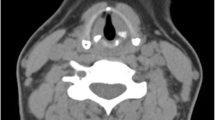Abstract
If botulinum toxin fails in the treatment of cervical dystonia, selective peripheral denervation is now accepted as the best surgical option. Despite the very promising results, however, there is still a substantial group of patients who do not benefit from this procedure. Positive response to prior botulinum toxin therapy seems to be a very good predictor of outcome after selective pepripheral denervation (P <0.01). The meaning of the histological findings of the resecte nerves is uncertain. Patients with histologically proven pathological nerves do not seem to benefit more than patients with histological normal ones (P <0.30).
Similar content being viewed by others
References
Anderson TJ, Rivest J, Stell R, Steiger MJ, Cohen H, Thompson PD, Marsden CD (1992) Botulinum toxin treatment of spasmodic torticollis. J R Soc Med 85:524–529
Bertrand CM (1993) Selective peripheral denervation for spasmodic torticollis: surgical technique, results and observations in 260 cases. Surg Neurol 40:96–103
Bertrand C, Molina-Negro P, Bouvier G, Gorczyca W (1987) Obeservations and analysis of results in 131 cases of spasmodic torticollis after selective denervation. Appl Neurophysiol 50: 319–323
Braun V, Richter HP (1991) Selective peripheral denervation in patients with spasmodic torticollis. Stereotact Funct Neurosurg 57: 113–122
Braun V, Richter HP (1994) Selective peripheral denervation for the treatment of spasmodic torticollis. Neurosurgery 35: 58–63
Gelb DJ, Lowenstein DH, Aminoff MJ (1989) Controlled trial of botulinum toxin injections in the treatment of spasmodic torticollis. Neurology 39: 80–84
Jancovic J, Orman J (1987) Botulinum toxin A for cranial-cervical dystonia: a double-blind placebo-controlled study. Neurology 37: 616–623
Richter HP, Braun V (1990) Die selektive periphere Denervierung zur Behandlung des Torticollis Spasmodicus. Fortschr Med 108: 59–64
Schröder JM, Huffmann B, Braun V, Richter HP (1992) Spasmodic torticollis: severe compression neuropathy in rami dorsales of cervical nerves C1-6. Acta Neuropathol 84: 416–424
Sorensen BF, Hamby WB (1966) Spasmosdic torticollis. Results in 71 surgically treated patients. Neurology 16: 867–878
Zöfel P (1985) Statistik in der Praxis. Fischer, Stuttgart, pp 197–200
Author information
Authors and Affiliations
Rights and permissions
About this article
Cite this article
Braun, V., Richter, HP. & Schröder, J.M. Selective peripheral denervation for spasmodic torticollis: is the outcome predictable?. J Neurol 242, 504–507 (1995). https://doi.org/10.1007/BF00867420
Received:
Revised:
Accepted:
Issue Date:
DOI: https://doi.org/10.1007/BF00867420




